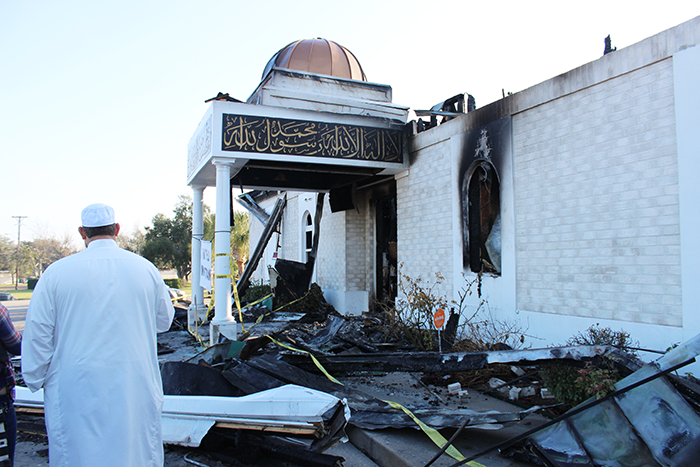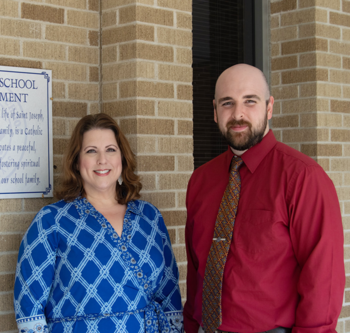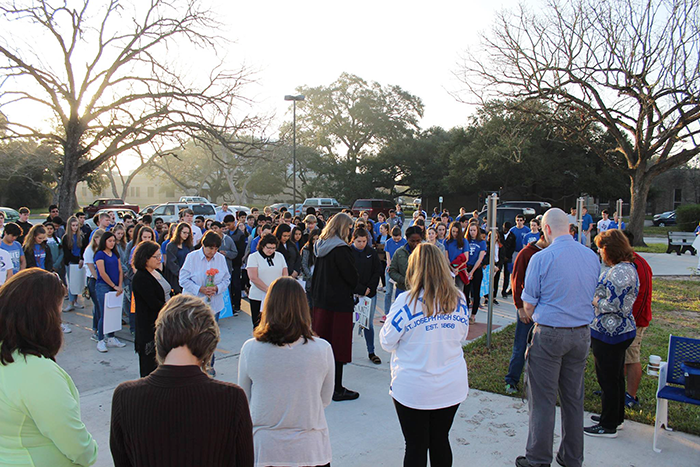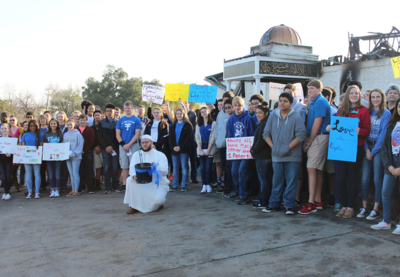In the early morning hours of January 28, 2017, less than a day after President Trump signed a travel ban targeting seven predominately Muslim countries, the Victoria Islamic Center in Victoria, Texas, was consumed in flames. It was later confirmed to be arson.
Early the next day, a post appeared on the Center’s Facebook page: “Please join us for a public prayer service at the grass area of the Victoria Islamic Center tomorrow Sunday, the 29th at 10:00 a.m. We will pray for peace and safety for all.”

The word went out, and so it came to be that Victorians of every religion, who had planned to worship at their own churches that morning, who had previous plans or no plans at all, converged by the hundreds on the site of the still-smoldering mosque. So many people came to the service that the streets surrounding the mosque had to be cordoned off for crowd control.
And that was just the beginning. Days later, students at nearby St. Joseph High School—a fixture in Victoria since 1868—took action that had a significant impact on the town.
The Town
Victoria, Texas, is a town with a long tradition of neighbor helping neighbor. In its early days, it was largely a ranching and agricultural community. Much of the land was flat, arid and dry. In such an inhospitable environment, geography required residents to rely upon one another for survival. Helping their neighbors, welcoming strangers and lending a hand are all central to Victorian identity.
After the mosque burning, more than one resident commented that the town acted exactly as it would have if it had been a church or someone’s house or barn that had burned down. One of them was Gretchen Boyle, chair of the English department at St. Joseph, and a lifelong Victoria resident.
“I think the town has always accepted the Muslim community,” she says. She also explains that the town newspaper, the Victoria Advocate, "has always covered the mosque fairly. People never read anything that would give them occasion to pause and say, ‘Hey, what are they doing there?’”
Quite the contrary, according to Omar Rachid, one of the mosque’s congregants, who notes that the mosque was a source of town pride for many residents. “If people had visitors from out of town, they would drive them by the mosque because they loved the building’s architecture,” Rachid says. “I think the majority of Victorians enjoyed the diversity the mosque brought to the town.”
St. Joseph High School
Despite being a Catholic school, St. Joseph has long had a diverse student body that’s included Hindus, Baptists, Episcopalians and Muslims, among people of other faiths. One faculty member describes the school as a virtual “melting pot” of religions.
Drew Westfahl, head of the school’s social studies department, explains that the diversity visible at St. Joseph is nothing new. “You go back and you look at our yearbooks from the ’20s and ’30s, and a half or a third of every class are Hispanic names, at a time the public schools here were segregated,” he says. “We’ve had lots of Muslim kids [who] went through our school for years and years.”
An Idea Forms
When Gretchen Boyle heard about the burning of the mosque, she had an idea. As with many ideas that come on suddenly, it soon seemed to take on a life of its own.
“All at once I could just visualize our students walking toward the site of the mosque,” Boyle says. “I envisioned something peaceful, supportive and gentle … a kind of walk of love.”

The idea grew from a sense of urgency Boyle felt based on her desire to show compassion to the Muslim community, especially since the Center and the school were virtually neighbors.
“Our school is about one mile from where the building had stood. The mosque was literally our neighbor. For me, it was never an issue of whether our school would do something. The issue was what we would do and when we would do it. In this situation, just offering good wishes was not enough. We had to take action,” Boyle says.
She texted her idea to Westfahl, a fellow advisor to the student council. “We can do this,” her text read. “I know that we can make this work.” Westfahl had himself been in the process of mulling over how the school could take action when he got the text. Her idea instinctively felt right to him. He was on board.
The Plan Takes Shape
By first period on Monday morning, the first school day after the fire, Westfahl knew that the fire at the mosque, not yet known to be arson, had to be addressed head-on. The question was how to do it. It was tricky to discuss because, at that time, few facts were known about the circumstances of the fire’s origin. It was surely a teachable moment—but what exactly was the lesson?
“The burning of the mosque was just a pit-in-your-stomach kind of thing,” Westfahl recalls. “I mean, you immediately think that something intentional has happened. But we didn’t know yet, and the kids didn’t have any information. Nobody had any information about the cause of the fire, so we hoped that it was an accident.”
In the absence of any tangible facts about who or what had started the fire—and in the midst of rumors, angst and a deluge of national media converging on a town entirely unaccustomed to the spotlight—Boyle and Westfahl had to figure out how to engage and mobilize the students. There was no prepared curriculum they could draw upon. And time was of the essence.
“We tried to make what had happened personal,” Westfahl remembers. “I focused on how many students who had gone to St. Joseph had gone to that mosque. Those students had served on the student council, had been on the honor roll and had experienced their share of challenges. They were not ‘other.’ They were one of us and they had lost their spiritual center.”
Hurriedly, a group of faculty and students made preparations for the walk. They worked with Imam Osama Salah Hassan and chose poems and readings for a little ceremony that was planned for when walkers arrived at the site. They chose a sapling from the school grounds to present to the imam. The group hoped that, when the mosque was rebuilt and new landscaping was done, the tree donated by St. Joseph would signify a fresh start.
Because the walk was taking place only a couple of days after the burning and people still weren’t sure how the fire had happened, organizers took every precaution to ensure that the walk was safe, from the route they chose to consulting with local police.
“A female teacher came up to me and said, ‘I don’t know what to do. My husband doesn’t want me to go on this walk. He’s just adamant about my safety,’” Boyle remembers. “Of course, I didn’t pressure her. But in the end, she was right there with us.”
The planners had considered whether to make the walk voluntary, whether to proceed with a normal school day. In the end, no one was pressured to take part and school started late that morning. That made the turnout even more powerful. Students could have used the late opening as an opportunity to sleep in or to just stay home.
But they didn’t.
“A Beautiful Human Chain”
The Walk of Love commenced at 8:00 a.m. on Wednesday, February 1. Several hundred students, faculty, parents and clergy wound through side streets and backyards that lay between the two buildings (with permission from the homeowners), just as Boyle had envisioned. They made up what Abe Ajrami, treasurer of the mosque, later described as a “beautiful human chain.” Some students carried handcrafted signs with messages reflecting what they had been so painstakingly taught: the power of love.

When the walkers arrived, they were greeted by Imam Hassan, Abe Ajrami and Omar Rachid, who created a GoFundMe page to support rebuilding efforts.* Other members of the mosque also attended. Imam Hassan later marveled at the breadth of the composition of the group; everyone from the school’s principal to its custodian was there. Prayers were said—both Christian and Muslim—and students read carefully selected poems and readings from scripture.
Ajrami recalls, “Just seeing these young people—the innocence and the love and the sincerity—was a wonderful thing and touched us deeply.”
The Aftermath
As residents of Victoria had suspected, the burning of the mosque was judged to be arson. On March 3, 2017, a suspect was arrested, partly as a result of tips from the community, and subsequently charged with a hate crime. He was tried and convicted on July 16, 2018. Ultimately, he was sentenced to 24 years in prison.
On September 29, 2018, the rebuilt Victoria Islamic Center had its grand opening. Hundreds of people attended the gathering. John Wilcox, a reporter for the Victoria Advocate, wrote, “Destroyed by flames of prejudice, the Victoria Islamic Center was rebuilt with unity.”
Victoria’s outpouring of support was immediate. But St. Joseph’s Walk of Love was unique. It both engaged and empowered young people by giving them a platform to show their neighbors, the mosque’s congregants, that they were not alone.
Father Gary Janak, pastor of The Cathedral of Our Lady of Victory, participated in the walk. “Arriving at the charred remains of the mosque, we listened to the words of the imam and other officials. As we did, I witnessed a change in the students,” he reflected. “In my opinion, they began to understand more clearly what the walk truly meant. It was not merely an attempt to show support to a people who had lost their place of worship. The walk was transformed into a lesson of human and spiritual connection. Many of the students were visibly moved by the words spoken by the leaders and members of the mosque.”
The Walk of Love sparked numerous classroom discussions throughout Victoria about what young people could do to show support and take action when another group was targeted. “At the end of the day, it isn’t about whether someone is Christian or Jewish or Muslim. … At the end of day, it’s all about love,” a student from Drew Westfahl’s class remembers. “That was the whole message of the walk. Afterwards, when we were walking back to the school, I was thinking about how anyone who might have had a part in burning the mosque down must have been feeling so stupid—like the community is just throwing back what they did in their face.”
The sapling donated to the Victoria Islamic Center by St. Joseph, as a symbol of love, solidarity and support, is now prominently displayed on the grounds of the mosque. Like the message of the walk, it has since taken root and grown, for all to see.
Cohn is a psychotherapist and writer. This article is an adapted chapter from her book in progress. For information about her professional background, visit www.drjanicecohn.com.
* The GoFundMe page, created to raise money for rebuilding the mosque and helped along by extensive media coverage, raised over $1 million in four days before the mosque ended the campaign. There were more than 23,000 contributions from across the United States and 91 countries around the world.
